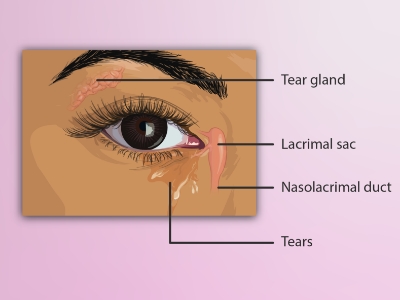Watery Eyes: Symptoms, Causes, and Treatment

Watery eyes can be due to many factors and conditions. In infants, persistent watery eyes, often with some matter, are commonly the result of blocked tear ducts. In babies, the tear duct may not be fully open and functioning for the first several months of life.
What are Watery Eyes?

Epiphora is the medical term for having watery eyes. Usually, tears lubricate and protect your eyes. Epiphora happens when something causes you to make too many tears or stops them from draining away from your eyes as they should.
Epiphora can happen for lots of reasons, many of which don’t need any treatment. It can be a temporary condition, but it can also be a sign of a serious eye infection or a blockage in your tear ducts. Visit your healthcare provider if your eyes are constantly watering or you’re having trouble seeing. Anyone can be affected by epiphora. Most people experience watery eyes at some point throughout their life. Epiphora happens frequently and is more common in babies and adults older than 50.
Signs and Symptoms of Watery Eyes
Symptoms of watery eyes include:
- Eyes that feel too wet or watery
- Tears running down your face
- Tears build up in your eyes when you’re not crying or laughing
What Causes Watery Eyes?
Watery eyes are usually a sign of another issue or condition that’s affecting your eyes or tear system. Some of the most common causes of epiphora include:

- Allergies
- Blepharitis
- Blocked tear ducts
- Dry eyes
- Styes
- Chalazion
- Entropion
- Eye injuries can also cause epiphora, including:
- Environmental irritants like smoke or air pollution
- Scratched corneas
- Dirt, debris, chemicals, or any foreign object that touches your eye for too long
Infections like pink eye or sinus infections can cause watery eyes, as well.
Treatment, Management, and Prevention of Watery Eyes
How your watery eyes are treated depends on what’s causing them. Many people experience temporary watery eyes that clear up on their own without any treatment.
Your provider will tell you which type of treatment you’ll need. The most common treatments include:
- Medications: You’ll need medication to treat your watery eyes if the epiphora is caused by allergies or an infection. If you have a condition like dry eye syndrome, your provider might prescribe artificial tears or prescription eye drops.
- Removing foreign objects: If there’s something in your eye or something hit your eye and damaged it, your provider will remove it or treat the damage. You might need surgery if a foreign object severely damaged your eye.
- Clearing blocked tear ducts: If you have blocked tear ducts, your provider will open them. They can flush them with a saline solution to rinse away the blockage. They can use a probe to open your tear ducts manually if they need to. If your tear ducts are damaged or blocked by something your provider can’t remove with either saline or a probe, you might need surgery to open them.
- Repairing your eyes or eyelids: If the physical shape of your eyes or eyelids is causing epiphora, your provider will repair the damage. You might need surgery to correct some issues.
Your provider will tell you how to manage your epiphora symptoms. If they prescribe a medication, make sure to take it or use it as often as they say. This is especially true if they give you antibiotics for an infection. You need to take antibiotics for as long as your provider prescribes, even if your symptoms improve. If you don’t take the full course of antibiotics, the infection might come back, get worse or spread to other parts of your body.
The recommended prescription used for the condition:
- Desloratadine – is an antihistamine that works by preventing the effects of a substance called histamine, which is produced by the body. Histamine can cause itching, sneezing, runny nose, and watery eyes.
Talk to your provider about ways you might be able to prevent watery eyes in the future.



